In advance of the third program in The Drawing Center’s Drafts series, Curatorial Assistant Nova Benway speaks with Vienna-based artist Nikolaus Gansterer about the generative potential of diagrams.
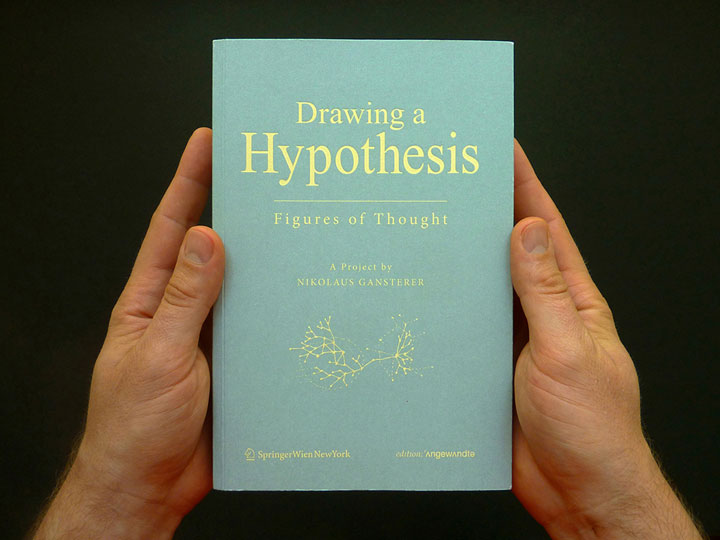
Nikolaus Gansterer, Drawing a Hypothesis – Figures of Thought, 2011. Published by Springer Verlag Wien, New York. Image courtesy of the artist.
Nova Benway: You just had an exhibition in Germany at the Kunstverein Bielefeld titled Schaubilder. Since your work deals with visibility and invisibility, let’s start with the question of what you showed.
Nikolaus Gansterer: I was showing work resulting from my project Drawing a Hypothesis – Figures of Thought (excerpt). For years I have had a strong fascination with diagrams (in German “Schaubilder”) and I was questioning how these relational visual artifacts—graphic forms visualizing complex associations—could be comprehended from an artistic point of view. In an intensive exchange with artists and scientists, I developed new forms of narratives and hypotheses by tracing the speculative potential of diagrams. Based on a discursive process, I sent my drawings to various interpreters with a request for a written interpretation (which I call “micrology”), so that in return I could react to their texts with diagrammatic drawings and models. In 2011 a publication resulted from this five-year exchange of figures of thought and figures of speech, describing, from various angles, the reflexive and dynamic character of diagrams.
My work shown at the exhibition at the Kunstverein Biefeld bears the title Table of Contents—literally displaying an arrangement of key figures of thought distilled/resulting from these inspiring conversations and transferred into fragile materiality. Here, drawing plays a crucial role in producing and communicating our knowledge(s), due to its ability to mediate between perception and reflection. For me drawing is a way to watch the mind working in the making of ideas, revealing thinking as an inter-subjective and translational process. It’s a balancing between visibility and invisibility.
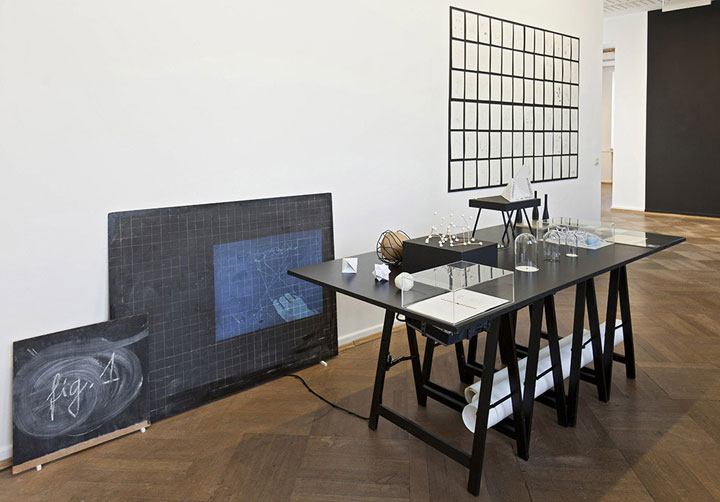
Nikolaus Gansterer, Table of Contents (installation view at Kunstverein Bielefeld, Germany), 2012/13. Models, drawings, projector with media player, Mpeg-file, 35 minute loop, dimensions variable. Photo: Philipp Ottendoerfer, 2013. Image courtesy of the artist.
NB: What constitutes a “figure of thought” for you? Does this form have definable parameters, or is it something more vague and intuitive?
NG: For me a “figure of thought” describes something dynamic and flexible, shifting rather than solid and static. My conception of the figure and figuration is deeply rooted in the Greek understanding of the term, which has a choreographic and performative notion, like “a body’s gesture caught in motion.” (See also Roland Barthes: A Lover’s Discourse, 1979.) It is both an elusive and highly lively form and, for me as artist, also a method to frame, name, and question a phenomenon by entering the field of my inquiry with a specific attitude, attention, and awareness. Due to the ambivalent character of the figure of thought, it’s interesting to use it as a vehicle and specific set of frames—maybe comparable to a system of lenses—to operate with.
NB: Can you give examples of interpretations your collaborators made for Drawing a Hypothesis that were particularly interesting to you?
NG: The multitude of explanations was most striking to me. In this project the potential of drawings and diagrams to activate the mind comes clearly to the forefront. I would argue that a diagram is a reflexive sign, empowering the reader in the process of reading and sense-making as it functions in a non-linear way. Thus it is probably closer to the nature of how our mind is organized and operates.
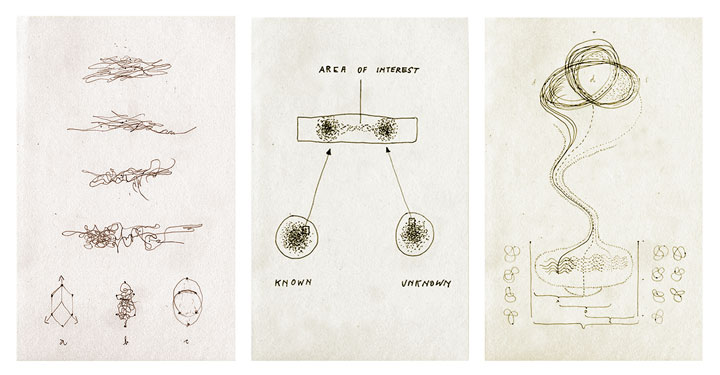
Nikolaus Gansterer, Figure 11/06, Figure 01/01, Figure 12/55 from Drawing a Hypothesis, 2011. Ink on paper, 8 1/4 x 5 15/16 inches each. Image courtesy of the artist.
Here again the performative character of diagrams plays an essential role. For example, the artist and theoretician Jane Tormey allowed herself to delve with all senses into the drawings and started living within and between the drawn lines. Letting herself be guided by the lines of thought, she directly inscribed her reflections onto the drawings and thus avoided simplistic description.[i] On the contrary, the radical cartographers Philippe Rekacewicz and Marc Boeckler individually delineated a set of witty captions, reflecting on our basic need for spatio-temporal representations by deconstructing mapping as a practice of topological narrations. The writers Moira Roth and Ferdinand Schmatz wrote beautiful poetic micrologies on modes in-between seeing and sensing. Systems analyst Gerhard Dirmoser developed an extensive alphabet of figures of thought—which I re-translated into a fold-out map. All these written hypotheses served for me as another starting point to develop new drawings, models, installations, or a series of gestures.
NB: What kind of new knowledge do you think was produced?
NG: In my work, the intuitive part of knowing is as vital as the so-called cognitive part. Drawing—which is for me always a performative act in time and space—offered a way to combine these modes of thinking and sensing (in) correlations. Based on my method of “reverse engineering a theory” (by initiating the process of knowing through a speculative approach to reading diagrams, inferring the information they represent), the resulting hypotheses are naturally of very different kinds, reflecting their authors’ particular fields of knowledge in this fractious zone between art, science, and fiction. Each collated reflection—be it a theoretical essay, a poem, or a drawing—produces a very specific form of knowledge, revealing an enticing glance into our sub/consciousness and the possible mental spaces between recognizing and naming. For me “not-(yet)-knowing” is more exciting and inspiring than mere knowing.
NB: You have also done this kind of interpretation live, correct? How does that change the process?
NG: In the last few years I have collaborated with theoreticians and artists in a series of performances which I call TransLectures. Often a text, a drawing, or a material marks the starting point for different layers of interpretations and re-translations. Here drawing—for me a medium of high immediacy—could turn the subject into a score, an ad-hoc diagram, a makeshift model, or an instruction for taking action. Within these performances the process of “drawing beyond drawing” is central and extended along the categories of time, space, and movement: a line of thought becomes a line on the paper, a line in space, a line verbalized, or even a line drawn with the whole body. Together with the writer Emma Cocker I developed a series called Drawing on Drawing a Hypothesis. Using processes of cross-reading and live drawing, we dissected my publication Drawing a Hypothesis in the search for key words and phrases and evocative fragments in order to re-edit its content live.
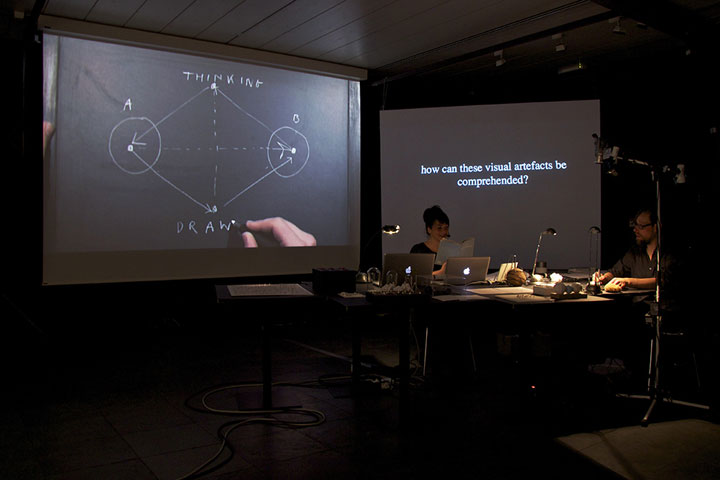
Nikolaus Gansterer and Emma Cocker, Drawing on Drawing a Hypothesis, 2011. Performance lecture at Kunsthalle Vienna, 2011. Photo: Simona Koch, 2011. Image courtesy of the artist.
I am now preparing for the next step of TransLectures, which will take place in July at a performance festival in Berlin called Foreign Affairs. Invited philosophers, sociologists, and economists will discuss the omnipresent phenomenon of betting and the desire for speculation, but also the enormous impact of the idea of “futures” on social interrelations. Parallel to the lectures I will be live transforming the speakers’ ideas into ad hoc diagrams and daring card house models (“bodies of theory”) by translating their ideas into fragile forms of materiality.
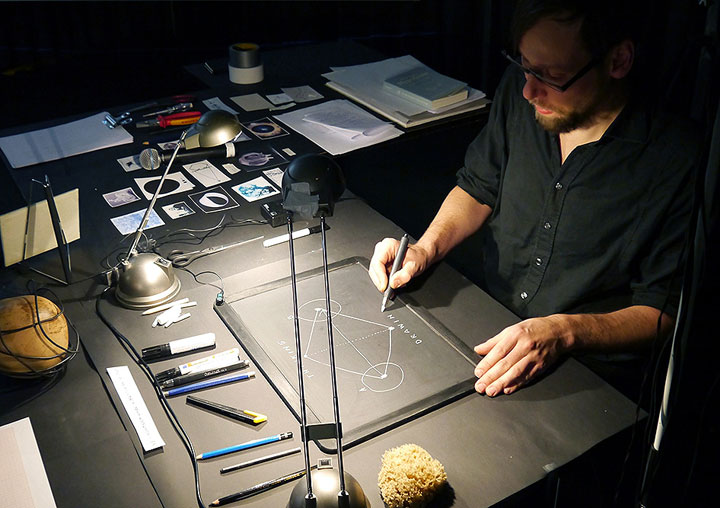
Nikolaus Gansterer, Thinking Drawing, 2011. Chalk diagram on blackboard during performance lecture at Museum of Modern Art, Antwerp, Belgium. Photo: Simona Koch, 2011. Image courtesy of the artist.
NB: Your work sounds perfectly suited to Drafts, the program series at The Drawing Center you’ve recently taken part in. Can you describe your participation, and what was interesting for you about the process?
NG: It was indeed a very exciting process. I felt familiar with the rather associative approach of the “cadavre exquis” applied to Drafts through my research into diagrams. It was fascinating to find new visual material relating to explanations and visualizations in the archives of the Reanimation Library. In my first investigation I felt drawn to figures that are rather abstract and open. In my intense exchange with Kaegan Sparks, we worked on a set of figures which, in the end, contained both movements: an “informed openness” combined with a specific speculative and poetic potential.
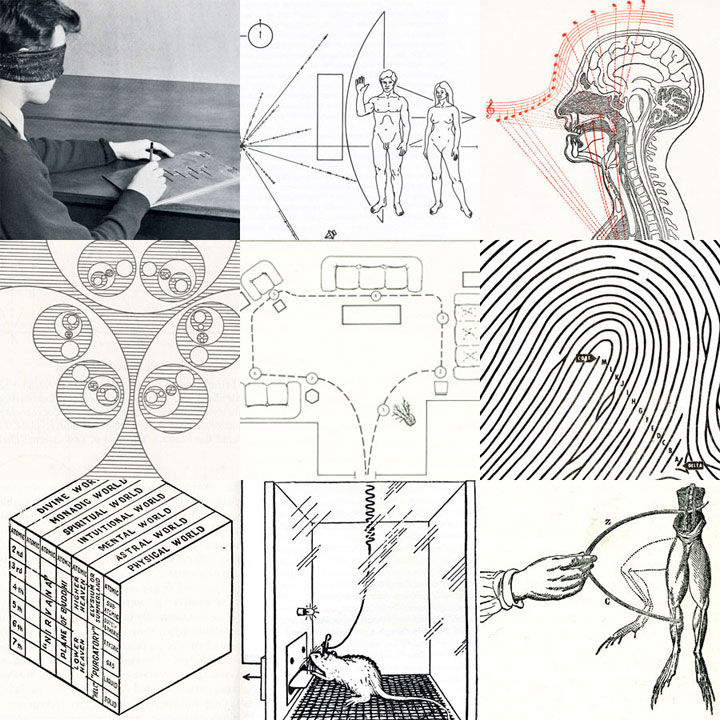
Composite of images from the Reanimation Library’s archive, selected by Nikolaus Gansterer for Drafts Phase III.
Drafts Phase III: Information Transmission (Bodies of Evidence) is scheduled for May 10, 2013 at 6:30 PM. The program, based on images of experimental apparatus selected by Nikolaus Gansterer, will include collaborative performances by Cally Spooner, Avi Alpert, Mashinka Firunts, and Danny Snelson.
View an excerpt of Drawing a Hypothesis here and video documentation of a Drawing on Drawing a Hypothesis performance here. More about Gansterer’s work can be found on his website.
[i] “If I enter the drawing and start living in this world, I can describe this other reality as if I were looking at the ‘scene’ as it unfold before me,” Jane Tormey, “The Afterthought of Drawing: 6 Hypotheses” in Drawing a Hypothesis, pp. 241-258.
